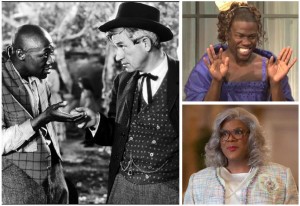In the early days of Hollywood, it was a common(and dare I say, accepted) practice to portray black people, and particularly black men in an especially loathful light. For decades before, during, and after the formation of Hollywood, the fate and imagery of blacks was(and is) decided by those controlling the purse strings of production, namely white folks. Blackface shows, also known as minstrel shows, had been a part of American culture since the 1800's, and was key in the continuation and reinforcement of stereotypes of the black man, as; shiftless, lazy, happy-go-lucky, irresponsible, cowardly(or savage depending on the context), primitive, oversexed, animalistic, easily swayed, and prone to crime and violence. Someone who, left to his own devices, would fall into all sorts of troublesome and destructive activities.
Of course, the undertone of such messaging is that as such, the black man was better suited to a position of subservience, wherein his "master" could do the thinking for him to keep him out of harms way, as well as from becoming a nuisance to others(society).
When the siege against the black male image began, the perpetrators of the image hijacking were white actors, made up to look like black men, in stories written by white men, for white audiences. That was par for the course, at the time, in the early days of Hollywood. After all, Tinseltown was just creating reflections of American beliefs and culture. Art reflects life, right?
The game-changer, however, came in the guise of a vaudeville actor by the name of Lincoln Theodore Monroe Andrew Perry, commonly known by his stage name; Stepin Fetchit.
Perry was a character actor, who managed a traveling carnival, and performed a vaudeville act with his partner. Originally, it was a duo that performed as Step and Fetchit, but after a subsequent split, Perry continued alone, combining the two names into Stepin Fetchit. One of the characters that he created, was "The Laziest Man In the World", and for some strange reason(I'm being sarcastic here), this character caught the eye of Hollywood producers, who consequently invited him to share(and immortalize) the persona on film. The popularity of the character was so great, that Stepin Fetchit went on to star in 54 films, and Perry became the first American black actor to become a millionaire.
Beyond that, Stepin Fetchit opened the door for other would be "coons" that followed in his shuffling footsteps; including the eye bugging Wille Best, Mantan Moreland, and William "Buckwheat" Thomas. Of course the list didn't stop there, and in fact continues to this day. There is no shortage of black actors (and actresses) these days, willing to sell out their culture and prostitute themselves for the sake of fortune and fame, short lived though it typically is. A quick scan of the "sellout" line will return a diverse list of names, ranging from David Mann(the "meet the browns" clown) to Academy Award winner, Cuba Gooding Jr. The reigning king and prince of the culture sellouts though, are Tyler Perry and Kevin Hart, respectively.
Yeah, I said it.
Even in the modern(so they say), corporate driven Hollywood, white folks continue to control the purse strings, and fund/reward the types of projects and artists that represent their idea of what and who the black man is. Their representation has seeped into the collective societal perception, just like the belief that if you wreck your car, and it starts leaking fluids, it's "going to explode".
Now, of course there is the argument, that were it not for "pioneers" such as Steppin Fetchit, who opened the doors for others(Hattie McDaniel is a common name tossed into this premise, along with Sidney Poitier), black people would not be where we are today. "Those roles were the only type of roles available to black folks at the time." and "That's how things were back then." are two statements I hear quite often.
Accepting that as true....why is it that 86 years later....Hollywood still rewards and cultivates the same imagery? This is a rhetorical question, by the way...we already know why.
To redirect the question....why is it that black people, in a post-slavery, post civil rights, post integration, "modern" era - even those in positions to change the direction of the game - continue in the participation, perpetuation, and cultivation of said imagery?
Could it be that life, steered by the pursuit of the dollar, now imitates art?
While you ponder that, let's move on to the treatment of the black woman's imagery...
To be continued....


